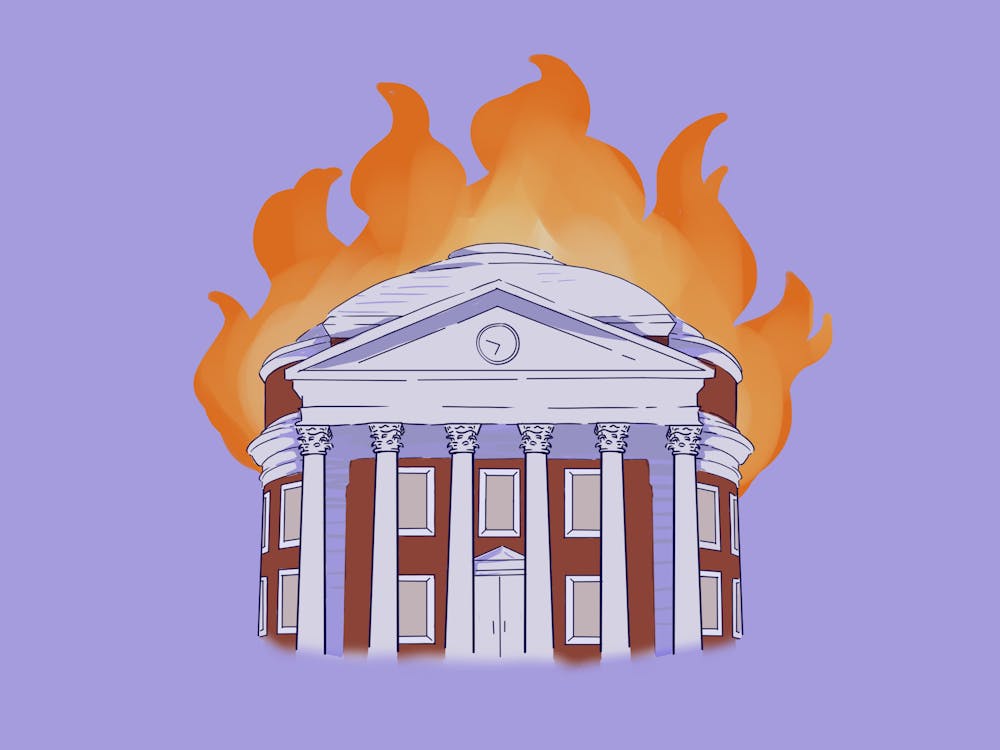If the Rotunda were on fire, bystanders would rush to its side, fervently working to extinguish the flames and repair any damage. Yet, that is precisely what is happening now, and little has been done to douse the fire.
Of course, the building is not literally on fire. Metaphorically, however, everything the building represents — learning, democracy, permanence and the endless pursuit of excellence — is being consumed by flames. The spark? Current political agendas that are weaponizing funding to suffocate academic research and disrupt the dissemination of knowledge and ideas. Through these measures, the government is stripping away research opportunities for countless students and thwarting life-saving research efforts, innovation and democratic progress.
On Grounds, the full extent of these flames became undeniably clear when former University President Jim Ryan resigned due to political pressure from the Department of Justice. In his resignation statement, Ryan highlighted the “catastrophic” consequences for the University and other institutions that refused to bow to the Trump administration's demands. One of these consequences includes cuts to funding for research programs in order to pressure institutions into making policy and institutional changes.
Central to these efforts is their undeniable political aim — the Trump administration is not simply reducing expenditures, it is deliberately weaponizing funding in order to enforce ideological conformity. By targeting diversity, equity and inclusion initiatives, the government is reducing the very intellectual diversity that is vital for academic innovation. Simultaneously, the administration is tightening international student visa policies in hopes of limiting international students' influence. These moves are not incidental policy adjustments, but rather, two fundamental parts of a broader campaign aimed at imposing a narrow, nativist ideology on universities and threatening both the autonomy of higher education and all research opportunities available to students.
These funding cuts are materializing as follows. Under the direction of the federal government, the National Institutes of Health and National Science Foundation are altering research funding policies, which effectively hamper universities’ ability to finance and maintain research efforts. Typically, most of a research grant’s funding goes toward direct costs of that research, while the indirect costs — such as IT infrastructure, building maintenance and administrative support — are covered through the process of indirect cost recovery, a funding mechanism through which organizations like universities recover costs for services and facilities. Those reimbursement rates are between 50 to 65 percent from the NIH and NSF. However, both agencies have recently capped indirect cost recovery at only 15 percent for research grants, meaning universities will lose hundreds of thousands of dollars per grant.
Evidently, the effects of these caps are not just abstract budgetary shifts. Instead, they have a direct effect on the amount of research universities can fund and the number of faculty they can hire to support innovative efforts. Additionally, such cuts also impact the total number of students who can enroll, engage or be supported in research positions. This distinction is crucial because it highlights how funding cuts undermine the broader capacity for innovation in universities, which is a very pillar of higher education.
For research programs nationwide, this essentially spells the end of enduring success. The more labs that are involved in research, the more difficult it becomes to support them financially. Large research entities, like the University, will need to scale back or cancel entire projects due to this funding cap. While these decisions may have initially been a political tactic to limit diversity in institutions of higher education, the impact is that these cuts are now crippling research efforts across universities, regardless of size. The full impact of funding cuts on America’s research infrastructure will soon become more apparent, as progress in both STEM and humanities research declines.
Take the University’s initiatives in precision medicine, social development and climate research, for example. Over the past several years, these projects — along with hundreds of others — have produced invaluable solutions like an advanced artificial pancreas system for Type 1 diabetics. These advances, along with any future initiatives, are being threatened, something which in turn endangers people’s lives and livelihoods. Patients may wait years longer for treatments that are already accessible or communities facing climate disasters could be left without research to guide prevention and recovery.
In short, the government is using targeted attacks on research funding to control university autonomy. Using the guise of limiting DEI initiatives and international student influence, they are directly threatening open inquiry in the pursuit of knowledge — the very pillar of our University’s founding. As the current members of Jefferson’s University, we must defend those ideals. Kneecapping the foundation of the country’s research enterprise just to follow nativist principles is an absurdly self-defeating, short-sighted strategy that is a threat to us all. The most concerning truth is that when political agendas dictate academic boundaries, we do not lose professors or programs — we lose progress.
The Rotunda is aflame, the academic world is on fire. And we are merely watching it burn.
Lucy Duttenhofer is an opinion columnist who writes about academics for The Cavalier Daily. She can be reached at opinion@cavalierdaily.com.
The opinions expressed in this column are not necessarily those of The Cavalier Daily. Columns represent the views of the authors alone.







